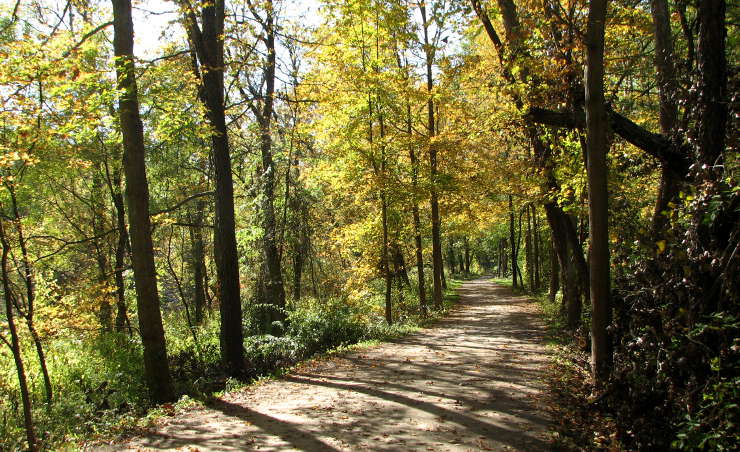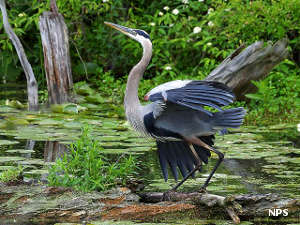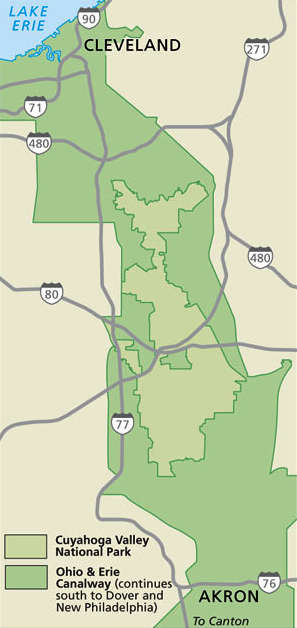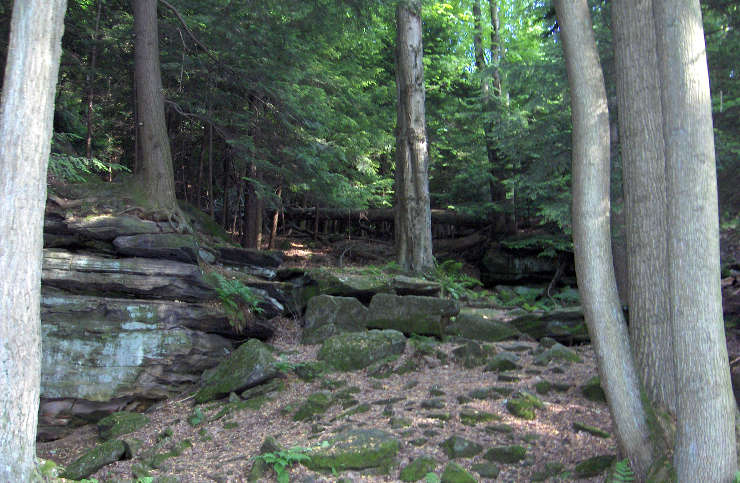Cuyahoga Valley National Park

Ohio & Erie Canal Towpath at Cuyahoga Valley National Park

The Ohio and Erie Canal was built between 1825 and 1832 to make it easier to freight goods between Lake Erie (Cleveland) and Portsmouth on the Ohio River. When complete the canal was 308 miles long. Other connections along the Ohio River allowed the easy shipping of goods on other canal systems in Pennsylvania. The canal carried traffic until 1861 when the railroads arrived and slowly killed the business. After 1861, the canal was principally used as a water source by various of the towns, villages and industries located along its route. Much of the canal was abandoned for the hauling of freight and supplying of water in 1913 after severe flooding crippled major sections of it.
In the 1870's, local folks began using certain areas along the canal as a getaway from the burgeoning cities and, over time, local businessmen donated sections of land to become parks and funds to support those parks. In the 1930's the CCC built infrastructure in some of those park areas but the area continued to grow and local citizens began working in the 1960's to preserve the natural beauty left in the area. In December 1974 President Gerald Ford signed a bill establishing the Cuyahoga Valley National Recreation Area.

Cuyahoga Valley National Park,
within the Ohio & Erie Canalway
National Heritage Corridor
In 1985 the National Park Service acquired the 47-acre Krejci Dump site to include in the Recreation Area. However, the Environmental Protection Agency surveyed the site and closed it in 1986. The survey had turned up massive amounts of very toxic materials and the site morphed into a superfund site almost overnight. The EPA began litigation against companies like Ford, GM, Chrysler, 3M and Waste Management of Ohio. All the companies settled except 3M, and 3M lost the case in court. Cleanup began in 1987 and isn't finished yet but a large part of the site has been restored to its natural wetlands state.
The Richfield Coliseum, an arena located halfway between Akron and Cleveland was the home of the Cleveland Cavaliers and multiple other sports teams between 1974 and 1994 when it became economically obsolete. The Coliseum hosted sports, wrestling and music events until (what is now) Quicken Loans Arena was built. The Richfield Coliseum was vacant after 1994 and finally torn down in 1999. The site became part of Cuyahoga Valley National Park when the park was designated and within two years after the arena was removed, the grassy area turned into one of the primary birding spots in northeastern Ohio.
Congress redesignated the National Recreation Area as Cuyahoga Valley National Park in 2000 and added other parcels to the National Park designated area. Today the park's designated boundary includes some 32,823 acres, 20,339 of those acres actually owned by the National Park Service and most of the rest held in regional parks or by compatible venues (Blossom Music Center, Hale Farm & Village).
Cuyahoga Valley National Park is open 24/7/365 except for certain areas that close at dusk and reopen at sunrise. The Boston Store Visitor Center is open in winter (first of November to the first of March) Mondays through Fridays from 10 am to 4 pm. In spring Mondays through Fridays from 10 am to 4 pm and Saturdays and Sundays from 9:30 am to 5 pm. In summer the Visitor Center is open daily from 8 am to 6 pm, in September and October from 9:30 am to 5 pm daily. There is no entrance fee to visit the park but should you come for any of the special events that happen on the property, there are usually fees for those.
The Ohio & Erie Canalway National Heritage Corridor was established to protect, preserve and promote areas along the length of the Ohio & Erie Canalway that are still in existence (two-thirds of the original canalway is not). Cuyahoga Valley National Park is completely contained within the boundaries of the Ohio & Erie Canalway National Heritage Corridor. Running the north-south length of the Ohio & Erie Canalway National Heritage Corridor is the Ohio & Erie Canalway National Scenic Byway.

Bedrock outcropping at Cuyahoga Valley National Park
Other photos and maps courtesy of the National Park Service